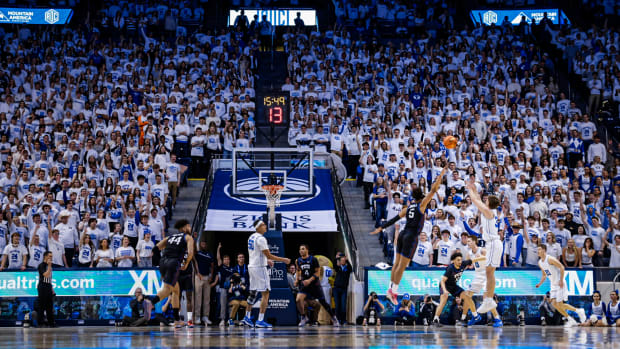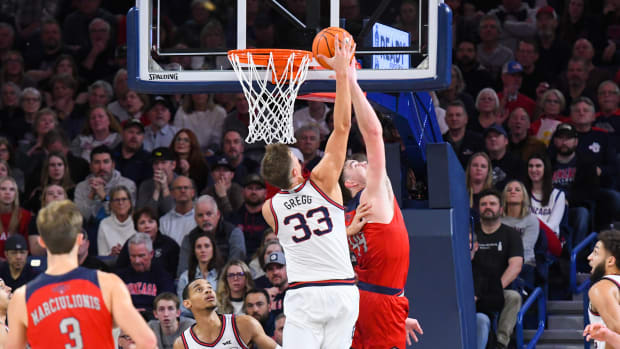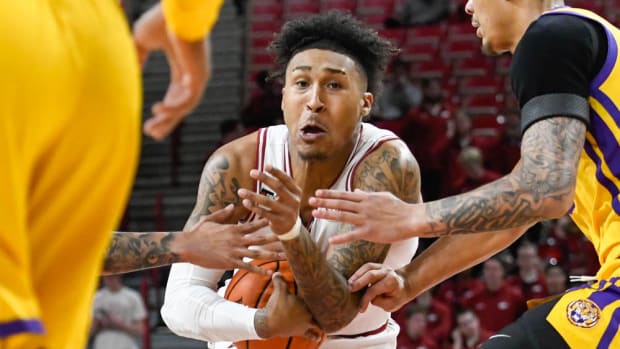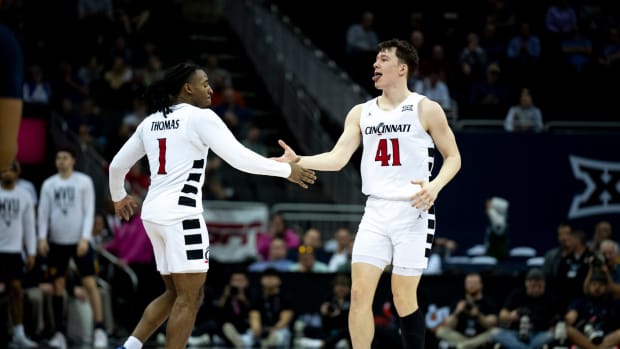The Significance of Ole Miss Standing Behind Its Players Who Knelt
Oxford Town around the bend
Come to the door, he couldn’t get in
All because of the color of his skin
What do you think about that, my friend?
— Bob Dylan, “Oxford Town”
On the campus of the University of Mississippi, up on the way to the library and not far from the Greek Revival campus trademark that they call the Lyceum, there’s a memorial in which a man is depicted walking through a pillared archway. The statue is of James Meredith, the first African-American to attend the university. In the fall of 1962, when Meredith attempted to enroll, white-nationalist resistance turned into outright armed sedition. Two people were killed. More than 300 more were injured. President John F. Kennedy sent federal marshals, and then federal troops, onto the campus. Before the violence abated two days later, the marshals and some of the soldiers were forced to take refuge within the Lyceum.
There are still bullet holes visible in the walls. The Lyceum was built in 1848. There is a monument in front of it honoring Confederate soldiers. The Lyceum itself was built by slaves.
That same fall, the Ole Miss football team went undefeated, beat Arkansas in the Sugar Bowl and won several of the unofficial national championships that were handed out back in those primeval days. The team played out its schedule in the middle of the violence that attended Meredith’s enrollment. Several of the players were caught up in the two nights during which the campus was thoroughly up for grabs. (These events were described in vivid detail by author Wright Thompson in a 2012 ESPN documentary called Ghosts of Ole Miss.) There was no sticking to sports on the campus of the University of Mississippi in the fall of 1962.
Last week, a motley collection of white-supremacist goons announced its intention to march in Oxford in defense of the continued presence of monuments to the Confederate States of America. There was a home basketball game that night between the Rebels and the University of Georgia. In response to the white-supremacist march, several of the Ole Miss players took a knee during the playing of the national anthem.
This, of course, was the latest demonstration of this sort, a gesture of protest that famously began with former 49ers quarterback Colin Kaepernick, who took a knee to protest the killing of unarmed African-Americans by the police. Since then, the gesture has been taken up by protesters around the world; last November, in South Africa, two Jewish students knelt throughout the playing of the Israeli national anthem prior to a middle-school soccer match to protest the Israeli government’s treatment of Palestinians in Gaza and elsewhere.
“Take a knee” has gone from a football coach’s command in practice to a gesture of protest against bigotry and unthinking authority figures—like, for example, police officers and the odd football coach. To their enormous credit, the administration at Ole Miss and head coach Kermit Davis were vocal and steadfast in their public support for the players, seven of whom eventually joined in the protest before the Georgia game. After the game, Davis explained why he was behind what his players had done.
“This was all about the hate groups that came to our community and tried to spread racism and bigotry,” he said. “It has created a lot of tension for our campus. I think our players made an emotional decision to show these people they aren’t welcome on our campus, and we respect our players’ freedom and ability to choose that.”
Meanwhile, Ross Bjork, the Ole Miss athletic director, and a man who clearly knows the fraught racial history of his university, added, “Our job is to teach and educate every single day. They’re human. They’re students. They see what’s happening on our campus. These people that come here and they spill hate and bigotry and racism, we don’t want them on our campus. Our players stood up for that. It had nothing to do with the anthem. It had nothing to do with anything beyond we don’t want those people here, they’re protesting during our game and that’s not right because that’s not the Ole Miss that I know. We talked to them about that in the locker room. We support them because we don’t want those people here either. The university doesn’t want them. Our town doesn’t want them. They’re out-of-state. They’re not from here. So good for the players to stand up and make a statement.”
If you lived through those perilous times, even at a distance, you know how revelatory those comments from white administrators in support of black protestors at the University of Mississippi truly are. It does not diminish the courage of the players in the least that the authority figures in their lives support them, but I’m sure it makes it easier.
What do you think about that, my friend?
However, at the same time, the players and the administrators had to scramble to explain that the protest did not rise from a disrespect for the flag or “the troops”, which always has been the most baffling part of the backlash against the taking of the knees. Even if you don’t understand that the protest is not aimed at the flag itself—and you have to really want not to understand that—how it is somehow disrespectful to the men and women in uniform takes rather lurid powers of analysis.
Of course, in the context of how militarized modern game presentation has become, any gesture of protest can be reverse-engineered into an insult to the military. Given how thoroughly the leagues and the teams have turned their games into Defense Department informercials, arguing with the guy at the beer stand could be reverse-engineered into the same thing. One of the very last crusades embarked upon by the late Senator John McCain was to end the practice of the Pentagon’s spending taxpayer dollars for what (sadly) became known as “paid patriotism” events at various games. But even those tawdry transactions are no match for history, and for the people who know their history and know how to use it to make their points about what’s going on today. When the seven players at Ole Miss took a knee, they were not alone. They had the support of their coach and their administration, certainly, but they had something else, too. They had the support of all that accumulated history. They had the federal marshals and soldiers, besieged in the Lyceum in what rightly might be called the last battle of the American Civil War. They had the Kennedy brothers. They had the power of memory. They had James Meredith.
Not that long ago, my son received his master’s degree from Ole Miss. We all gathered in The Grove, which may be the best place on any campus in America, and then we walked up the hill toward the Lyceum. It was a bright and beautiful day, aromatic with all manner of flowers and lyrical with bird song. Eventually, we found ourselves at the Meredith monument. We all sat down for a while to enjoy the day. One after another, African-American families, gathered to celebrate the graduation of a son or a daughter, or a grandson or a granddaughter, stopped by to take pictures of themselves at the memorial. Some of the older folks were civil rights movement veterans, explaining to the younger children what had happened once on this very ground, where it took an army for one student to enroll in the place where they all were gathered now in the sunshine.
I went back to that memory last week when the Mississippi players knelt to defy the bloodier parts of their university’s history. I remembered the sunshine and the flowers and the song of the birds, and the laughter of the families around the memorial, and I remembered it as a kind of sacramental moment, rich with sacrifice. It was like being at a vast ceremony, ghosts invited.
“The past is never dead. It's not even past.” — William Faulkner




